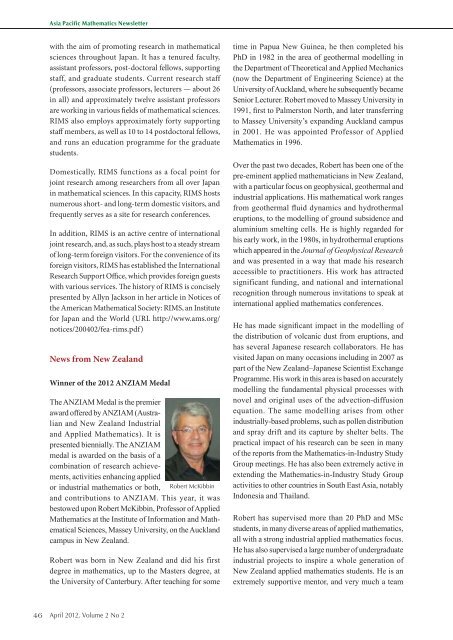Mathematics Newsletter
Mathematics Newsletter
Mathematics Newsletter
Create successful ePaper yourself
Turn your PDF publications into a flip-book with our unique Google optimized e-Paper software.
46<br />
Asia Pacific <strong>Mathematics</strong> <strong>Newsletter</strong><br />
with the aim of promoting research in mathematical<br />
sciences throughout Japan. It has a tenured faculty,<br />
assistant professors, post-doctoral fellows, supporting<br />
staff, and graduate students. Current research staff<br />
(professors, associate professors, lecturers — about 26<br />
in all) and approximately twelve assistant professors<br />
are working in various fields of mathematical sciences.<br />
RIMS also employs approximately forty supporting<br />
staff members, as well as 10 to 14 postdoctoral fellows,<br />
and runs an education programme for the graduate<br />
students.<br />
Domestically, RIMS functions as a focal point for<br />
joint research among researchers from all over Japan<br />
in mathematical sciences. In this capacity, RIMS hosts<br />
numerous short- and long-term domestic visitors, and<br />
frequently serves as a site for research conferences.<br />
In addition, RIMS is an active centre of international<br />
joint research, and, as such, plays host to a steady stream<br />
of long-term foreign visitors. For the convenience of its<br />
foreign visitors, RIMS has established the International<br />
Research Support Office, which provides foreign guests<br />
with various services. The history of RIMS is concisely<br />
presented by Allyn Jackson in her article in Notices of<br />
the American Mathematical Society: RIMS, an Institute<br />
for Japan and the World (URL http://www.ams.org/<br />
notices/200402/fea-rims.pdf)<br />
News from New Zealand<br />
Winner of the 2012 ANZIAM Medal<br />
The ANZIAM Medal is the premier<br />
award offered by ANZIAM (Australian<br />
and New Zealand Industrial<br />
and Applied <strong>Mathematics</strong>). It is<br />
presented biennially. The ANZIAM<br />
medal is awarded on the basis of a<br />
combination of research achievements,<br />
activities enhancing applied<br />
or industrial mathematics or both, Robert McKibbin<br />
and contributions to ANZIAM. This year, it was<br />
bestowed upon Robert McKibbin, Professor of Applied<br />
<strong>Mathematics</strong> at the Institute of Information and Mathematical<br />
Sciences, Massey University, on the Auckland<br />
campus in New Zealand.<br />
Robert was born in New Zealand and did his first<br />
degree in mathematics, up to the Masters degree, at<br />
the University of Canterbury. After teaching for some<br />
April 2012, Volume 2 No 2<br />
time in Papua New Guinea, he then completed his<br />
PhD in 1982 in the area of geothermal modelling in<br />
the Department of Theoretical and Applied Mechanics<br />
(now the Department of Engineering Science) at the<br />
University of Auckland, where he subsequently became<br />
Senior Lecturer. Robert moved to Massey University in<br />
1991, first to Palmerston North, and later transferring<br />
to Massey University’s expanding Auckland campus<br />
in 2001. He was appointed Professor of Applied<br />
<strong>Mathematics</strong> in 1996.<br />
Over the past two decades, Robert has been one of the<br />
pre-eminent applied mathematicians in New Zealand,<br />
with a particular focus on geophysical, geothermal and<br />
industrial applications. His mathematical work ranges<br />
from geothermal fluid dynamics and hydrothermal<br />
eruptions, to the modelling of ground subsidence and<br />
aluminium smelting cells. He is highly regarded for<br />
his early work, in the 1980s, in hydrothermal eruptions<br />
which appeared in the Journal of Geophysical Research<br />
and was presented in a way that made his research<br />
accessible to practitioners. His work has attracted<br />
significant funding, and national and international<br />
recognition through numerous invitations to speak at<br />
international applied mathematics conferences.<br />
He has made significant impact in the modelling of<br />
the distribution of volcanic dust from eruptions, and<br />
has several Japanese research collaborators. He has<br />
visited Japan on many occasions including in 2007 as<br />
part of the New Zealand–Japanese Scientist Exchange<br />
Programme. His work in this area is based on accurately<br />
modelling the fundamental physical processes with<br />
novel and original uses of the advection-diffusion<br />
equation. The same modelling arises from other<br />
industrially-based problems, such as pollen distribution<br />
and spray drift and its capture by shelter belts. The<br />
practical impact of his research can be seen in many<br />
of the reports from the <strong>Mathematics</strong>-in-Industry Study<br />
Group meetings. He has also been extremely active in<br />
extending the <strong>Mathematics</strong>-in-Industry Study Group<br />
activities to other countries in South East Asia, notably<br />
Indonesia and Thailand.<br />
Robert has supervised more than 20 PhD and MSc<br />
students, in many diverse areas of applied mathematics,<br />
all with a strong industrial applied mathematics focus.<br />
He has also supervised a large number of undergraduate<br />
industrial projects to inspire a whole generation of<br />
New Zealand applied mathematics students. He is an<br />
extremely supportive mentor, and very much a team


